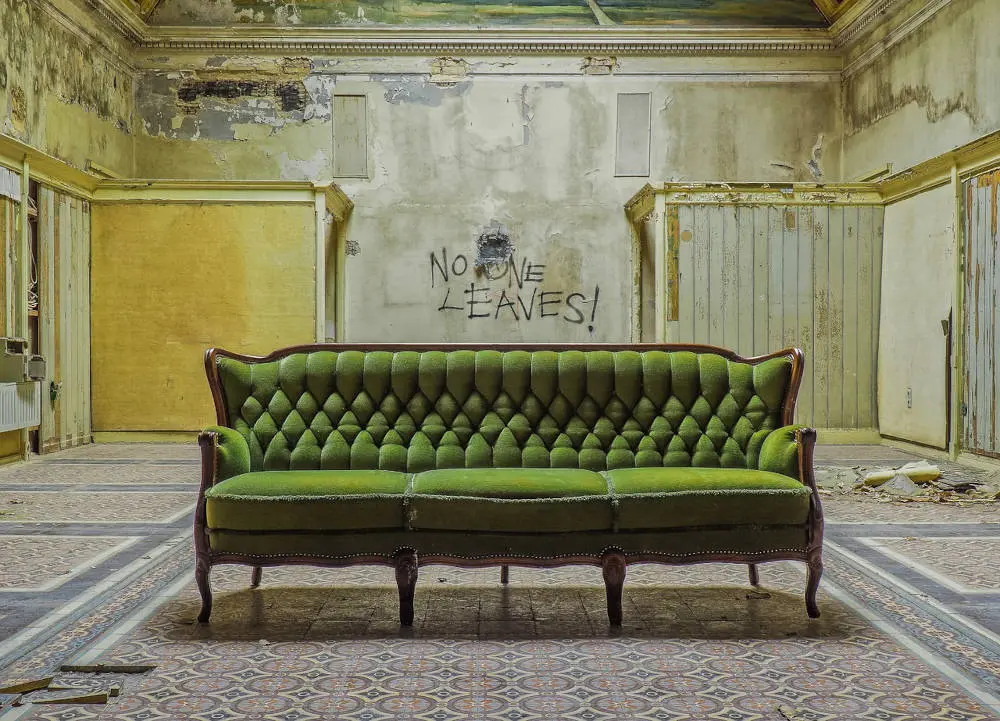Wenn die Wohnung krank macht. Ein Phänomen, das Schlaf- und ChronoCoaches auf dem Schirm haben…

Sick building syndrome - the secret sleep disorder?
Sick building syndrome is a completely underestimated source of sleep problems. No, we are not talking about a sick and dilapidated building, but a phenomenon that we simply cannot avoid and that sleep coaches and ChronoCoaches need to have on their radar.
Sick building syndrome (SBS) refers to a collection of symptoms that occur in people who spend long periods of time in certain buildings. Typical complaints include headaches, mucous membrane irritation, fatigue, allergic reactions and general malaise, but also sleep disorders, waking up at night, etc.. The focus here is not only on structural and environmental aspects.
First fast check of possible causes
The main causes of sick building syndrome are varied and often interlinked:
- Poor ventilation: Insufficient air exchange can lead to the accumulation of pollutants.
- Pollutants from building materials: Certain building materials can release volatile organic compounds (VOCs) that pollute indoor air.
- Mold and bacteria: Moisture and a lack of hygiene encourage the growth of microorganisms that can cause health problems.
- Insufficient lighting: A lack of daylight and poor artificial lighting can impair well-being.
- Electrosmog: Electronic devices and inadequately shielded cables can generate electromagnetic fields that cause symptoms in sensitive people.
- Water veins: In the context of geopathology, it is assumed that underground water veins, i.e. flowing water or groundwater streams, can generate energetic interference fields.
- Feng Shui: Unfavorable room layouts, incorrectly placed furniture or blocked energy flows ("Chi") can promote discomfort according to this doctrine.
The effects of sick building syndrome on health and sleep are complex, but can be described in one word: Negative
Pollutants
Pollutants can enter the home in several ways.
- Furnishings - The spectrum is broad, ranging from floor and wall coverings and their processing materials (e.g. adhesives) to curtains and furniture and their processing materials.
- Entry via the air - e.g. with open windows and front doors. This is particularly difficult, as this is how fresh air should actually enter the room.
- Building materials used in construction/renovation - Building materials themselves can initially be harmless, but poor workmanship can lead to pollutants being introduced later. Asbestos is of course known as a hazardous building material in this context, but the rest?
Similar to nutrition, the accumulation of harmful substances is often a problem. While one product may still comply with the limit, the accumulation of several products together may exceed the limit values. This can have a harmful effect. The resulting symptoms such as headaches, breathing difficulties or skin irritation can ultimately make it difficult to fall asleep and reduce the quality of sleep, not to mention the health consequences.
Molds and bacteria
Mold is a core problem that many buildings have to contend with. The main cause is divided into 2 areas.
Poor ventilation – Daily ventilation, especially after sleep, ensures drier rooms, provided the humidity outside is lower than inside. Shock ventilation is preferable to prolonged ventilation, especially in the cold seasons. Tip: Keep a ventilation log or install sensors that record when the windows are opened.
Building defects – Poor building materials or poor workmanship of the building materials can also be the cause of mold growth. In the same way, weathering can of course lead to damage to the building fabric, which in turn also promotes mold growth and thus the development of sick building syndrome. It is particularly important for tenants to consult a building biologist if they are accused of poor ventilation.
A study of over 5,000 people has shown that people living in buildings affected by mold are more likely to complain of sleep problems, chronic fatigue and concentration problems1. However, this can happen not only directly, but also indirectly, as another study has shown2. This research shows that asthma and allergies, especially in children, but also in adults, can be caused by mold spores in the workplace, which in turn promotes sleep disorders such as insomnia or nocturnal awakenings.
Magnetic radiation/electrosmog
Electrosmog and magnetic radiation can also enter indoor spaces. In addition to the electromagnetic fields generated in the building, for example by WLAN routers, cell phones or electrical appliances, there are also external sources that can be harmful to health:
- High-voltage power lines: Buildings located near high-voltage power lines are exposed to higher electromagnetic field strength. Studies suggest that long-term exposure could be associated with an increased health risk, even if the exact mechanism of action is still unclear.
- Mobile phone masts: Transmission masts for mobile phone networks and 5G technologies generate electromagnetic radiation that can cause symptoms such as headaches or sleep disorders in sensitive people.
- Railroad power lines: The electromagnetic fields from railroad lines, especially overhead lines, can affect nearby buildings.
For particularly sensitive people, the use of shielding measures is recommended, such as special protective paints, curtains with shielding fabric or the relocation of bedrooms to areas away from the radiation.
Water veins
In the context of geopathology, it is assumed that underground water veins, i.e. flowing water or groundwater streams, can generate energetic interference fields. These interference fields are said to influence the sleeping area in particular, as the body reacts more sensitively to such influences during the resting phase. People who complain of insomnia, inner restlessness or feeling unwell in the morning often report an improvement in their symptoms if their sleeping area is relocated or specifically cleared. However, critics see this as a placebo effect, as there are no scientifically reliable studies on this. Nevertheless, the perception of such influences can improve the mental state.
Feng Shui
The traditional Chinese teaching of Feng Shui places great importance on the harmonious design of rooms. Unfavorable room layouts, incorrectly placed furniture or blocked energy flows (“chi”) can therefore promote discomfort. In the bedroom, the central place for regeneration and sleep, particular attention should be paid to the positioning of interference fields according to Feng Shui. Electronic devices should be removed to minimize electromagnetic influences. Natural materials and calming colors also support a sleep-promoting atmosphere. Feng Shui can therefore also have a positive effect on the subjectively experienced harmony of a room.
The burden of consciousness
Now the knowledge of possible dangers poses a further problem, because awareness of an unhealthy environment can in turn trigger stress and anxiety, which can also have a negative impact on sleep and health. And there is another factor: the workplace. Even if you can influence building materials, interior design, etc. at home, this is generally not possible at work. Sure, you don’t (usually) sleep there, but the effects can be amplified if you add them to the stress at home.
Recommendations for improving the situation
It is important for us as sleep and ChronoCoaches to include sick building syndrome in our analysis of sleep problems and either exclude or identify it as a possibility. This is why this point is also part of our ChronoCoach® training.
As a result, building biologists are professional contacts when it comes to finding solutions to reduce or at best eliminate the risk of sick building syndrome. But you can also do something yourself. Here is a non-exhaustive selection of approaches for healthy living and sleeping:
-
Better air quality:
1. Mechanical ventilation systems and air purifiers with high-quality filters help to reduce pollutants.
2. houseplants such as green lilies or hemp can improve the air quality. -
Minimize interference fields and electrosmog:
1. Test with the help of a geopath to see if there are any water veins or geopathic interference fields. Relocating your sleeping area can help in such cases.
2. install shielding devices against electromagnetic radiation, e.g. special paints or nets.
3. switch off electronic devices completely at night and deactivate WLAN routers at least during rest periods. -
Take feng shui principles into account:
1. Arrange furniture so that the energy flow is not blocked.
2 Ensure a harmonious design with calming colors and natural materials. -
Pay attention to the choice of location:
1. When constructing new buildings or relocating, ensure that the surroundings are as low-radiation as possible (distance from high-voltage power lines and mobile phone masts). If necessary, ask the building authority whether such buildings are planned!
2. for existing buildings, expert advice from a building biologist may be useful.
Conclusion
According to the Velux study “The indoor generation”, we now spend 95% of our time indoors. Despite all this, sick building syndrome is a rather unknown, but all the more complex phenomenon.
The effects of this on sleep are particularly serious, as night-time regeneration is of crucial importance for health. A holistic approach – including geopathic influences, feng shui principles and external stress caused by electrosmog – can help to create a healthier living and sleeping environment, provided you have the possibilities and means to do so. If it is actually the responsibility of those responsible to provide information on the health problems of various building materials, it is ultimately up to the consumer to inform themselves, as it is often only specific “probing” that leads to the desired information.
Professional sleep and chrono coaches should definitely have sick building syndrome on their radar!
Note
This article on Sick Building Syndrome is an excerpt from the teaching materials for the Chronooach® training course at the Immer Ausgeschlafen Akademie.
This scientifically based and unique training perfectly complements the knowledge of coaches in nutrition, fitness, life, resilience, epigenetics, personality, sleep, leadership and much more.
Sources:
1Wang, J., Janson, C., Lindberg, E., Holm, M., Gislason, T., Benediktsdóttir, B., Johannessen, A., Schlünssen, V., Jogi, R., Franklin, K. A., & Norbäck, D. (2020). Dampness and mold at home and at work and onset of insomnia symptoms, snoring and excessive daytime sleepiness. Environment International, 139, 105691.https://linkinghub.elsevier.com/retrieve/pii/S0160412020301008
2D.Caillaud, B.Leynaert, M.Keirsbulck R.Nadif, “Indoor mold exposure, asthma and rhinitis: findings from systematic reviews and recent longitudinal studies”, European Respiratory Review 2018 27(148): 170137; DOI: https://doi.org/10.1183/16000617.0137-2017
Further sources:
- Federal Institute for Research on Building, Urban Affairs and Spatial Development (BBSR): Sick Building Syndrome (bbsr.bund.de)
- Allnatura: Sick building syndrome (allnatura.at)
- Electrosmog Information Center (elektrosmog.com)
- Feng Shui Association Germany (fengshui-verband.de)
- Velux: The indoor generation. https://youtu.be/NNEiIWCss1I?si=1mUUjiKwz-MCkYkN
Zum Thema passende Beiträge
- Sick Building Syndrom - Toxische Schlafstörung?
- Sleep headphones - 3 alarming reasons against digital sleep masks
Sleep headphones - solution or problem? Sleep is a very complex topic, as is the…
- Flabby without sleep - erectile dysfunction due to poor sleep?
Erectile dysfunction due to sleep problems - is that possible? In principle, it can be…


